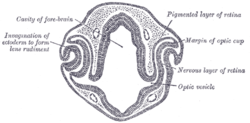Eye development


The eye begins to develop as a pair of optic vesicles on each side of the forebrain at the end of the 4th week of pregnancy. Optic vesicles are outgrowings of the brain which make contact with the surface ectoderm and this contact induces changes necessary for further development of the eye. Through a groove at the bottom of the optic vesicle known as choroid fissure the blood vessels enter the eye. Several layers such as the neural tube, neural crest, surface ectoderm, and mesoderm contribute to the development of the eye.[1]
Sequential inductions
This development is an example of sequential inductions where the organ is formed from three different tissues:
Neural tube ectoderm (Neuroectoderm)
First, there is an outpocketing of the neural tube called optic vesicles. Development of the optic vesicles starts in the 3-week embryo, from a progressively deepening groove in the neural plate called the optic sulcus. As this expands, the rostral neuropore (the exit of the brain cavity out of the embryo) closes and the optic sulcus and the neural plate becomes the optic vesicle.[2]
Neuroectoderm gives rise to the following compartments of the eye:
- Retina
- Epithelial lining of Ciliary body and Iris
- Optic nerves
- vitreous
Surface Ectoderm
The optic vesicles come into contact with the surface ectoderm which thickens to form the lens placode.
The lens differentiates and invaginates until it pinches off from the ectoderm. The lens acts as an inducer back to the optic vesicle to transform it into the optic cup and back to the ectoderm to transform it into the cornea.
The optic cup then delaminates into two layers: The neural retina and the retinal pigment epithelium.
Surface ectoderm produces the following parts:
Neural crest
Neural crest cells are themselves derived from the ectoderm and lie close to the neural tube:
Mesoderm
Mesoderm contributes to the following structures:
- Extraocular muscles
- Endothelial lining of blood vessels of the eye
- sclera & choroid
Developmental cascade
According to Liem et al., the organogenesis of the eye is pointed out as an example of a developmental cascade of inductions. The eye is essentially a derivative of the ectoderm from the somatic ectoderm and neural tube, with a succession of inductions by the chordamesoderm.
Chordamesoderm induces the anterior portion of the neural tube to form the precursors of the synapomorphic tripartite brain of vertebrates, and it will form a bulge called the diencephalon. Further induction by the chordamesoderm will form a protrusion: the optic visicle. This visicle will be subsequently invaginated by means of further inductions from the chordamesoderm. The optic visicle will then induce the ectoderm that thickens (lens placode) and further invaginates to a point that detaches from the ectoderm and forms a neurogenic placode by itself. The lens placode is affected by the chordamesoderm making it to invaginate and forms the optic cup composed by an outer layer of neural retina and inner layer the pigmented retina that will unite and form the optic stalk. The pigmented retina is formed by rods and cones and composed of small cilia typical of the ependymal epithelium of the neural tube. Some cells in the lens vesicle will be fated to form the cornea and the lens vesicle will develop completely to form the definitive lens. Iris is formed from the optic cup cells.
Responsivity of head epidermis
Only the epidermis in the head is competent to respond to the signal from the optic vesicles. Both the optic vesicle and the head epidermis are required for eye development. The competence of the head epidermis to respond to the optic vesicle signals comes from the expression of Pax6 in the epidermis. Pax6 is necessary and sufficient for eye induction. This competenece is acquired gradually during gastrulation and neurulation from interactions with the endoderm, mesoderm, and neural plate.
Regulation and inhibition
Sonic hedgehog reduces the expression of Pax6. When Shh is inhibited during development, the domain of expression for Pax6 is expanded and the eyes fail to separate causing cyclopia.[3] Overexpression of Shh causes a loss of eye structures.
Retinoic acid generated from vitamin A in the retina plays an essential role in eye development as a secreted paracrine signal which restricts invasion of perioptic mesenchyme around the optic cup.[4] Vitamin A deficiency during embryogenesis results in anterior segment defects (particularly cornea and eyelids) that lead to vision loss or blindness.
There is some evidence that LMX1B plays a role in periocular mesenchymal survival.[5]
Additional images
-

-

Optic cup and choroidal fissure seen from below, from a human embryo of about four weeks.
-

Horizontal section through the eye of an eighteen days’ embryo rabbit. X 30.
-

Sagittal section of eye of human embryo of six weeks.
-

Section of developing eye of trout.
References
- ↑ Sadler, T.W (1990). Langman's medical embryology (6th ed. ed.). Williams and Wilkins. ISBN 0683074938.
- ↑ "eye(vertebrate) McGraw-Hil; Encyclopedia of Science and Technology (2007), vol.6, pp.801-802
- ↑ "Development of the Vertebrate Eye -- Developmental Biology -- NCBI Bookshelf". Retrieved 2010-04-10.
- ↑ Duester, G (September 2008). "Retinoic acid synthesis and signaling during early organogenesis". Cell 134 (6): 921–31. doi:10.1016/j.cell.2008.09.002. PMC 2632951. PMID 18805086.
- ↑ McMahon C, Gestri G, Wilson SW, Link BA (August 2009). "Lmx1b is essential for survival of periocular mesenchymal cells and influences Fgf-mediated retinal patterning in zebrafish". Dev. Biol. 332 (2): 287–98. doi:10.1016/j.ydbio.2009.05.577. PMID 19500562.
External links
| |||||||||||||||||||||||||||||||||||||||